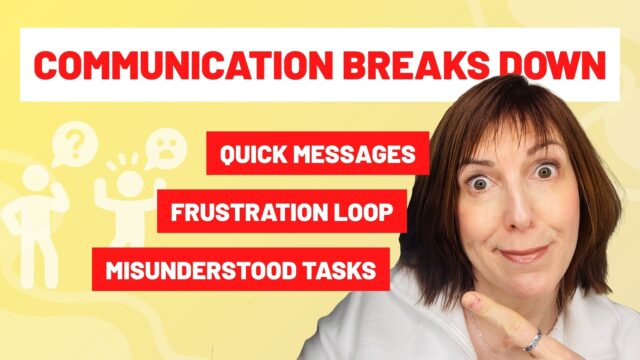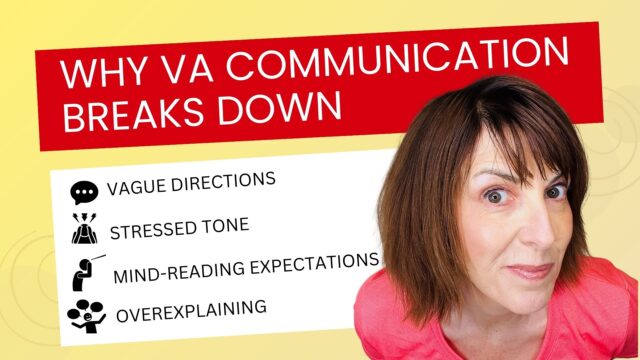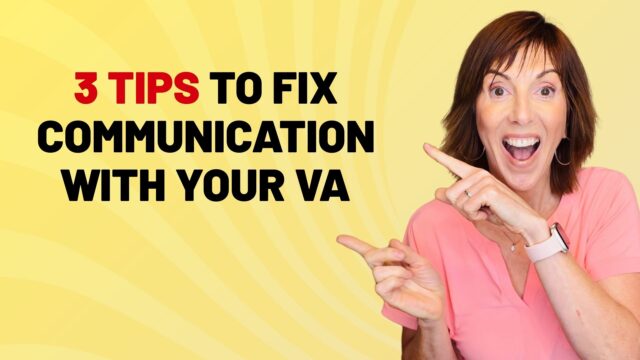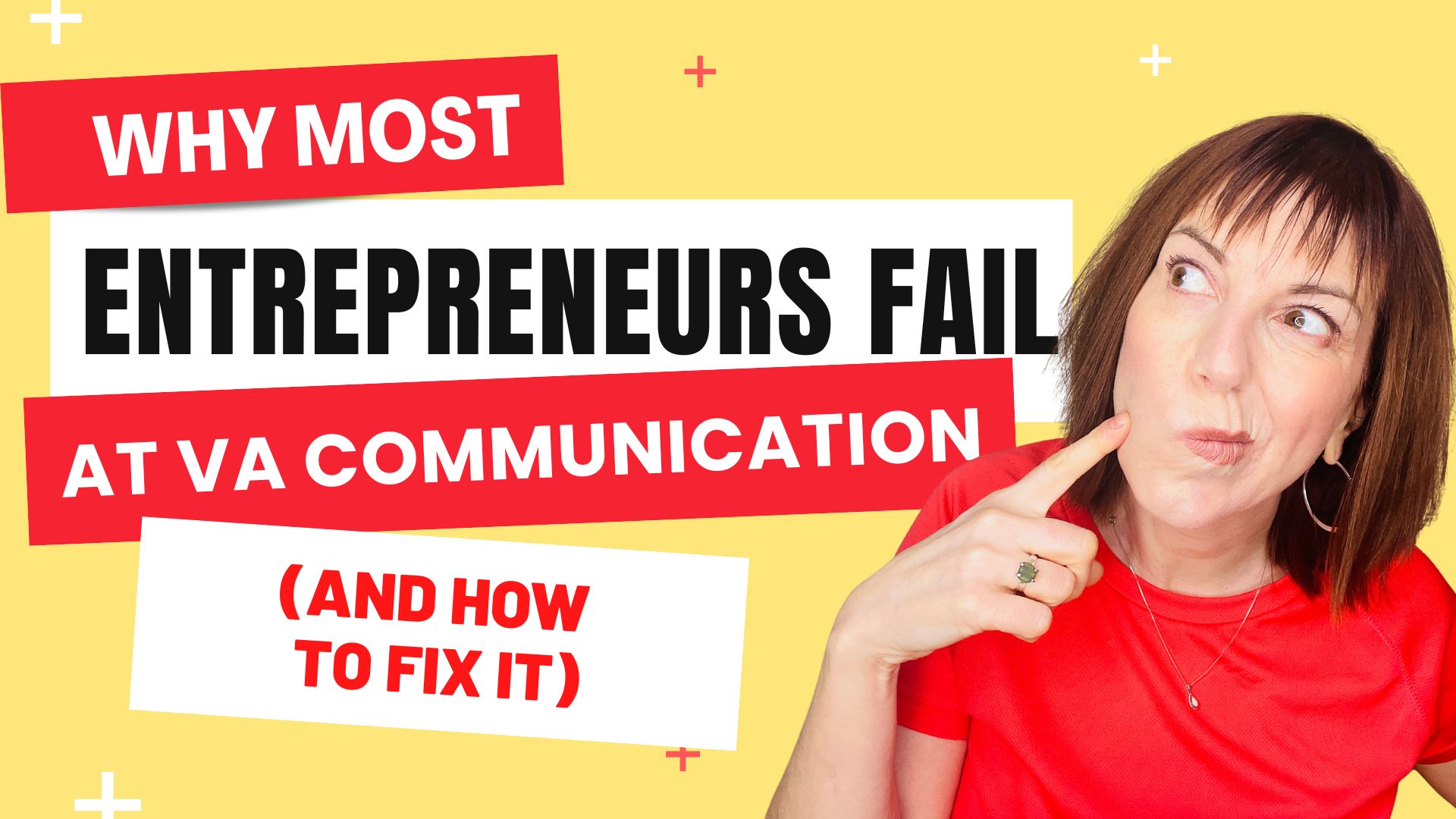How to Master Virtual Assistant Communication and Stop Losing Great VAs
You don’t lose good virtual assistants because they’re not capable.
You lose them because virtual assistant communication breaks down.
It starts small.
You fire off a quick message because you’re rushing between calls.
They nod, smile, or type back “yes.”
But the work that comes back isn’t what you expected.
Now you’re frustrated.
They’re confused.
And both of you are stuck in a loop.

By the end of this blog, you’ll see why most entrepreneurs struggle with virtual assistant communication, what it’s really costing them, and the simple fixes that build clarity, trust, and consistency.
The Real Problem Isn’t the VA
Most entrepreneurs blame the virtual assistant.
“They’re not proactive.”
“They don’t take ownership.”
“They stopped caring.”
That VA was probably motivated when they started.
But the way directions were given made it harder and harder to succeed.
You know how it goes.
You think you’re being clear, but you’re rushed.
You pile on too many details, or not enough.
Or you expect them to figure out things you never explained.

After a while, they stop asking.
Not because they don’t care, but because it feels safer to keep their head down.
That’s how virtual assistant miscommunication eats away at a good working relationship.
Why Virtual Assistant Communication Breaks Down
Here are the common traps I see every single week when working with entrepreneurs:
Vague directions
You think you’re being clear when you say, “Fix this up.”
But what does that really mean?
To you, it might mean fix the formatting.
To your VA, it could mean rewrite the whole thing…
redesign the layout…
or polish grammar.
You’re talking about one thing.
They’re hearing another.
Stressed tone
When you’re rushed, your tone shifts.
You don’t notice it…
but they do.
Your VA hears the stress in your voice…
or reads it between the lines in your message.
Instead of asking follow-up questions…
they stay quiet.
They don’t want to add to your stress.
Over time, silence builds.
And small misunderstandings pile up.
Overexplaining
You try to cover everything so nothing gets missed.
The problem is…
they walk away not knowing what matters most.
A long voice note.
A huge email.
Or ten messages in a row.
It leaves them sorting through noise…
instead of focusing on the real priority.

Mind-reading expectations
You assume they’ll “just know” how you want it done…
because it feels obvious to you.
But unless you’ve spelled it out…
your VA is guessing.
And when their guess doesn’t match your unspoken standard…
both of you get frustrated.
These problems don’t mean you’re a bad entrepreneur.
They mean your virtual assistant communication system isn’t set up to support growth.
And if your VA communication isn’t set up the right way…
you’re not scaling.
You’re just surviving.
How to Fix Communication with Your VA
This is the part most people skip.
But it’s also the part that changes everything.
If you want your VA to stay, grow, and actually make your life easier…
you need a system for virtual assistant communication that builds trust and momentum.
Here’s how to set it up:
Tip # 1: Use Short Daily Scrums
Most entrepreneurs rely on random check-ins or long email threads.
That’s where things get messy.
Your VA is left waiting for answers…
or sitting on problems until they pile up.
Instead, hold short scrums every day.
Fifteen to twenty minutes is all it takes.
Your VA shares updates.
They flag roadblocks.
They get clear direction before anything gets out of hand.
Why this works: scrums create a safe space.
When your VA knows they’ll have a set time to check in…
they stop hesitating.
They speak up sooner.
That steady rhythm builds trust.
It clears up small issues…
before they turn into bigger ones.
Scrums are the backbone of effective virtual assistant communication.
Tip # 2: Shift Into Leadership Language
Your words shape the relationship.
When you talk as a manager, it shuts things down:
“Do it this way.”
“Why didn’t you finish this?”
Whereas, when you talk as a leader, it opens things up.
“Here’s what works best.”
“What do you think we should try here?”
One creates pressure.
The other creates ownership.
Why this works: leadership language changes how your VA shows up.
When you use it, they don’t just follow directions.
They think.
They contribute.
They start leading parts of the work themselves.
And that’s when you finally stop carrying everything alone.

Tip # 3: Balance Feedback with Encouragement
Feedback keeps things moving.
But encouragement keeps people around.
If your VA only hears what went wrong…
they’ll stop taking risks.
They’ll stop trying new things.
That’s why I use the 3:1 approach in my Leadership Program.
Three supportive comments for every one correction.
Why this works: support builds confidence.
Confidence builds initiative.
And initiative is what keeps a VA growing with you long-term.
The truth is, people don’t stay because they’re paid.
They stay because they feel valued.
And when your VA feels valued…
they’ll keep investing their energy into your business as if it were their own.

What the Research Shows
Harvard research on team performance found that “psychological safety”…
the belief that you can speak up without being shut down, is the top factor in high-performing teams.
Which means communication isn’t just a nice-to-have.
It’s the difference between a VA who sticks around and one who ghosts you after a few months.
Client Story: From Frustration to Flow
One client of mine, Sarah, was convinced she’d hired the wrong VA.
She said the VA seemed quiet, hesitant, and slow to get things done.
When I reviewed the situation, it turned out Sarah’s instructions were rushed and inconsistent.
Her VA was second-guessing everything.
We added short scrums.
We shifted how Sarah gave feedback.
And we worked on building clarity into her instructions.
Within weeks, the VA was thriving.
Tasks were done faster.
There were fewer mistakes.
And the VA started suggesting improvements that saved hours each week.
Sarah didn’t need a new VA.
She needed better virtual assistant communication.
Final Thoughts: Communication Builds Scale
You don’t lose VAs because they’re not capable.
You lose them because communication falls apart.
But you can fix that.
Start with short scrums.
Use leadership language.
Balance corrections with encouragement.
That’s what creates strong virtual assistant communication.
And that’s what keeps your VA, and your business, moving forward.
FAQs on Virtual Assistant Communication
Can any VA become a better communicator?
Yes, but only if you give them the environment to do it. Confidence grows from consistency.
How soon will I see a change?
You’ll notice improvements right away once you start daily scrums and use leadership language. Bigger changes usually show up within a couple of months.
Should my VA be the one to create systems?
No. You provide the framework. They can improve it, but expecting them to build your business structure is unrealistic.








